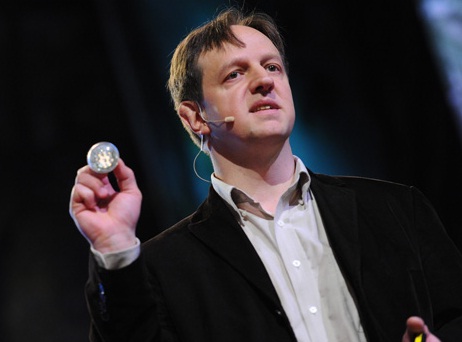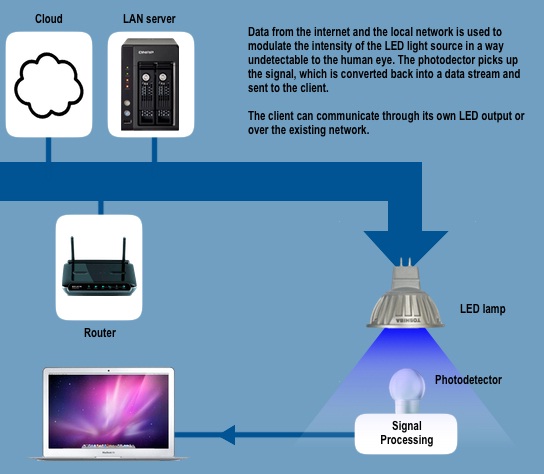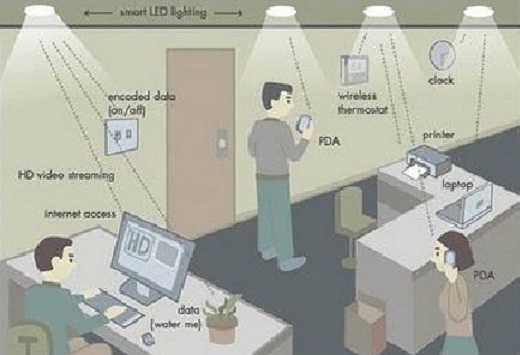





Published on Feb 14, 2025
Whether you’re using wireless internet in a coffee shop, stealing it from the guy next door, or competing for bandwidth at a conference, you’ve probably gotten frustrated at the slow speeds you face when more than one device is tapped into the network.
As more and more people and their many devices access wireless internet, clogged airwaves are going to make it increasingly difficult to latch onto a reliable signal. But radio waves are just one part of the spectrum that can carry our data. What if we could use other waves to surf the internet?
One German physicist,DR. Harald Haas, has come up with a solution he calls “Data Through Illumination”—taking the fiber out of fiber optics by sending data through an LED light bulb that varies in intensity faster than the human eye can follow. It’s the same idea behind infrared remote controls, but far more powerful. Haas says his invention, which he calls D-Light, can produce data rates faster than 10 megabits per second, which is speedier than your average broadband connection. He envisions a future where data for laptops, smartphones, and tablets is transmitted through the light in a room. And security would be a snap—if you can’t see the light, you can’t access the data.
Li-Fi is a VLC, visible light communication, technology developed by a team of scientists including Dr Gordon Povey, Prof. Harald Haas and Dr Mostafa Afgani at the University of Edinburgh. The term Li-Fi was coined by Prof. Haas when he amazed people by streaming high-definition video from a standard LED lamp, at TED Global in July 2011. Li-Fi is now part of the Visible Light Communications (VLC) PAN IEEE 802.15.7 standard. “Li-Fi is typically implemented using white LED light bulbs. These devices are normally used for illumination by applying a constant current through the LED. However, by fast and subtle variations of the current, the optical output can be made to vary at extremely high speeds. Unseen by the human eye, this variation is used to carry high-speed data,” says Dr Povey, , Product Manager of the University of Edinburgh's Li-Fi Program ‘D-Light Project’.
In simple terms, Li-Fi can be thought of as a light-based Wi-Fi. That is, it uses light instead of radio waves to transmit information. And instead of Wi-Fi modems, Li-Fi would use transceiver-fitted LED lamps that can light a room as well as transmit and receive information. Since simple light bulbs are used, there can technically be any number of access points.
This technology uses a part of the electromagnetic spectrum that is still not greatly utilized- The Visible Spectrum. Light is in fact very much part of our lives for millions and millions of years and does not have any major ill effect. Moreover there is 10,000 times more space available in this spectrum and just counting on the bulbs in use, it also multiplies to 10,000 times more availability as an infrastructure, globally.
It is possible to encode data in the light by varying the rate at which the LEDs flicker on and off to give different strings of 1s and 0s. The LED intensity is modulated so rapidly that human eyes cannot notice, so the output appears constant.
More sophisticated techniques could dramatically increase VLC data rates. Teams at the University of Oxford and the University of Edinburgh are focusing on parallel data transmission using arrays of LEDs, where each LED transmits a different data stream. Other groups are using mixtures of red, green and blue LEDs to alter the light's frequency, with each frequency encoding a different data channel.
Li-Fi, as it has been dubbed, has already achieved blisteringly high speeds in the lab. Researchers at the Heinrich Hertz Institute in Berlin, Germany, have reached data rates of over 500 megabytes per second using a standard white-light LED. Haas has set up a spin-off firm to sell a consumer VLC transmitter that is due for launch next year. It is capable of transmitting data at 100 MB/s - faster than most UK broadband connections.
Harald Haas, a professor at the University of Edinburgh who began his research in the field in 2004, gave a debut demonstration of what he called a Li-Fi prototype at the TEDGlobal conference in Edinburgh on 12th July 2011. He used a table lamp with an LED bulb to transmit a video of blooming flowers that was then projected onto a screen behind him. During the event he periodically blocked the light from lamp to prove that the lamp was indeed the source of incoming data. At TEDGlobal, Haas demonstrated a data rate of transmission of around 10Mbps -- comparable to a fairly good UK broadband connection. Two months later he achieved 123Mbps.

Li-Fi is typically implemented using white LED light bulbs at the downlink transmitter. These devices are normally used for illumination only by applying a constant current. However, by fast and subtle variations of the current, the optical output can be made to vary at extremely high speeds. This very property of optical current is used in Li-Fi setup. The operational procedure is very simple-, if the LED is on, you transmit a digital 1, if it’s off you transmit a 0. The LEDs can be switched on and off very quickly, which gives nice opportunities for transmitting data. Hence all that is required is some LEDs and a controller that code data into those LEDs. All one has to do is to vary the rate at which the LED’s flicker depending upon the data we want to encode.
Further enhancements can be made in this method, like using an array of LEDs for parallel data transmission, or using mixtures of red, green and blue LEDs to alter the light’s frequency with each frequency encoding a different data channel. Such advancements promise a theoretical speed of 10 Gbps – meaning one can download a full high-definition film in just 30 seconds.

TTo further get a grasp of Li-Fi consider an IR remote.(fig 3.3). It sends a single data stream of bits at the rate of 10,000-20,000 bps. Now replace the IR LED with a Light Box containing a large LED array. This system, fig 3.4, is capable of sending thousands of such streams at very fast rate.

Light is inherently safe and can be used in places where radio frequency communication is often deemed problematic, such as in aircraft cabins or hospitals. So visible light communication not only has the potential to solve the problem of lack of spectrum space, but can also enable novel application. The visible light spectrum is unused, it's not regulated, and can be used for communication at very high speeds.
| Are you interested in this topic.Then mail to us immediately to get the full report.
email :- contactv2@gmail.com |